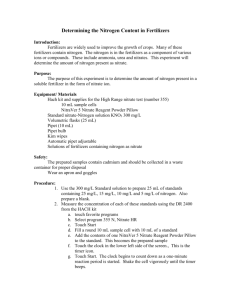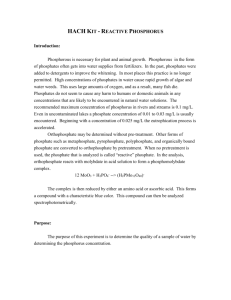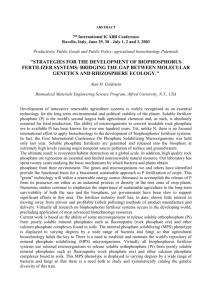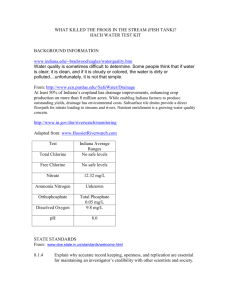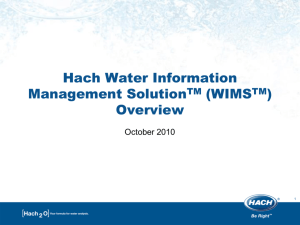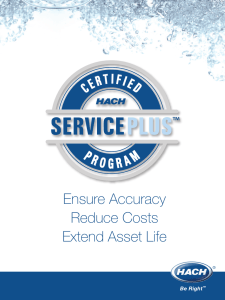Determining the Phosphate Content in Fertilizers
advertisement
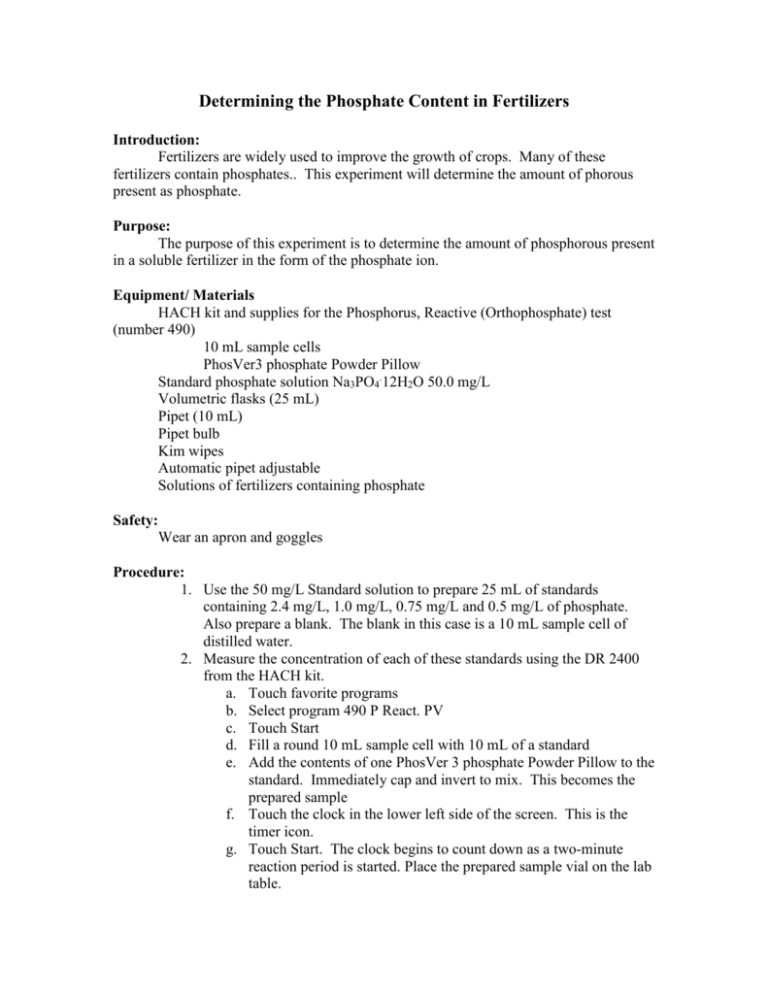
Determining the Phosphate Content in Fertilizers Introduction: Fertilizers are widely used to improve the growth of crops. Many of these fertilizers contain phosphates.. This experiment will determine the amount of phorous present as phosphate. Purpose: The purpose of this experiment is to determine the amount of phosphorous present in a soluble fertilizer in the form of the phosphate ion. Equipment/ Materials HACH kit and supplies for the Phosphorus, Reactive (Orthophosphate) test (number 490) 10 mL sample cells PhosVer3 phosphate Powder Pillow Standard phosphate solution Na3PO4.12H2O 50.0 mg/L Volumetric flasks (25 mL) Pipet (10 mL) Pipet bulb Kim wipes Automatic pipet adjustable Solutions of fertilizers containing phosphate Safety: Wear an apron and goggles Procedure: 1. Use the 50 mg/L Standard solution to prepare 25 mL of standards containing 2.4 mg/L, 1.0 mg/L, 0.75 mg/L and 0.5 mg/L of phosphate. Also prepare a blank. The blank in this case is a 10 mL sample cell of distilled water. 2. Measure the concentration of each of these standards using the DR 2400 from the HACH kit. a. Touch favorite programs b. Select program 490 P React. PV c. Touch Start d. Fill a round 10 mL sample cell with 10 mL of a standard e. Add the contents of one PhosVer 3 phosphate Powder Pillow to the standard. Immediately cap and invert to mix. This becomes the prepared sample f. Touch the clock in the lower left side of the screen. This is the timer icon. g. Touch Start. The clock begins to count down as a two-minute reaction period is started. Place the prepared sample vial on the lab table. h. Wipe the blank and place it into the cell holder. i. When the timer beeps, Touch Zero. The display will show 0.0 mg/L PO43-. j. Within one minute after the timer beeps, (indicating completion of the Zero reading), wipe the prepared sample and place it into the cell holder. k. Touch Read. l. Results will appear in mg/L PO43-. Record data m. Repeat until all standards have been measured. Record data. 3. Obtain a sample of fertilizer solution 4. Repeat step 2 using the fertilizer solution. Record data 5. Repeat step 2 using additional fertilizers. Record data Data: Standards Prepared Concentration (mg/L) 2.4 HACH meter reading (mg/L) 1.0 0.75 0.5 Fertilizer Kind of fertilizer used ______________________________________ HACH meter reading _______________________________________ Kind of fertilizer used ______________________________________ HACH meter reading _______________________________________ Kind of fertilizer used ______________________________________ HACH meter reading _______________________________________ Calculations: 1. Using the equation C1V1 = C2V2, calculate the volume of 50.0 mg/L PO43solution needed to prepare 25 mL of a solution containing 2.4 mg/L PO43- 2. Using the equation C1V1 = C2V2, calculate the volume of 50.0 mg/L PO43solution needed to prepare 25 mL of a solution containing 1.0mg/L PO43- 3. Using the equation C1V1 = C2V2, calculate the volume of 50.0 mg/L N solution needed to prepare 25 mL of a solution containing 0.75 mg/L PO43- 4. Using the equation C1V1 = C2V2, calculate the volume of 50.0 mg/L PO43solution needed to prepare 25 mL of a solution containing 0.50 mg/L PO43- 5. Graph your data. Plot the prepared concentrations on the x axis and the HACH meter readings on the Y axis 6. Using the calibration curve constructed above and the HACH meter reading, calculate the concentration of PO43- in your fertilizer. Questions 1. Why was a calibration curve constructed.? 2. List three errors that would cause phosphate readings to be too low. 3. List two errors that would cause phosphate readings to be too high.
